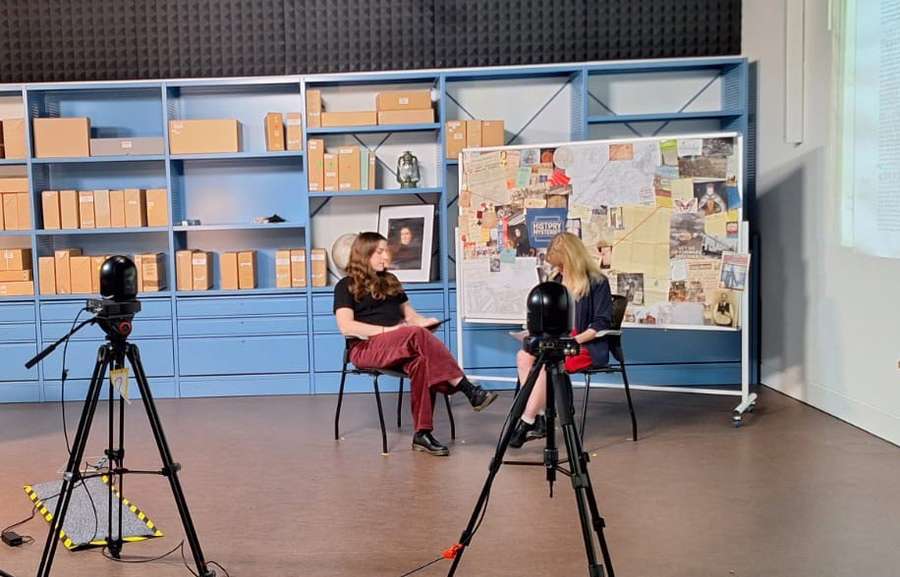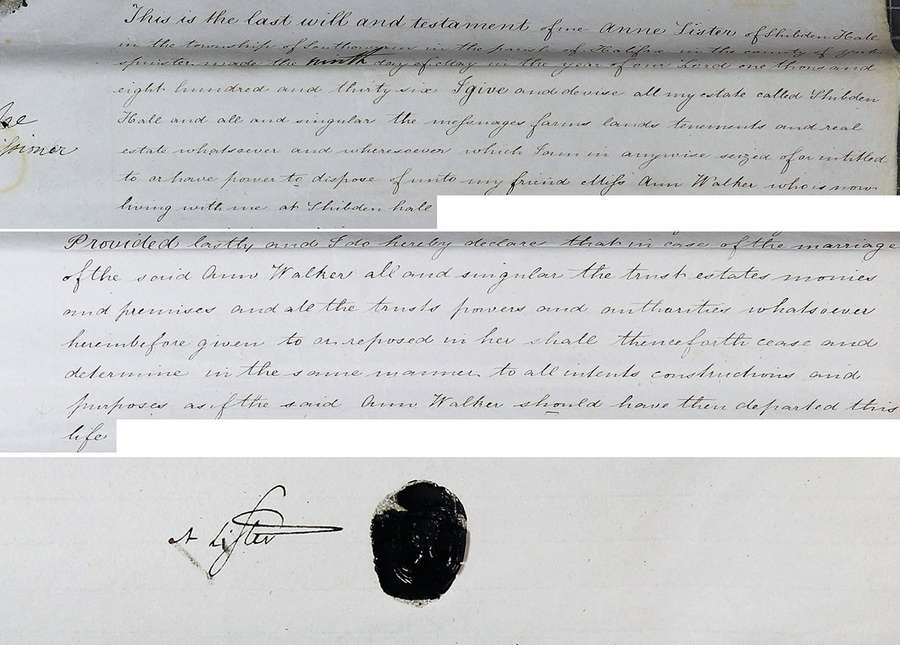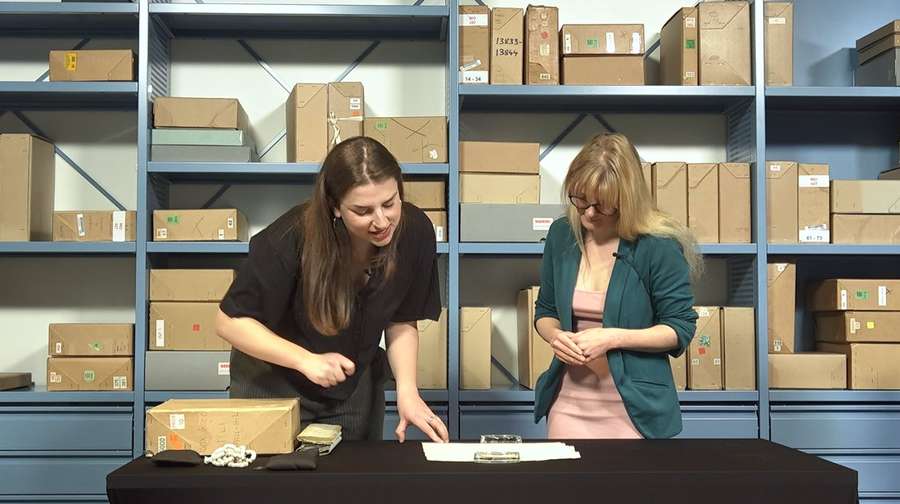Developed with diverse records specialist Vicky Iglikowski-Broad, Shibden Hall, and Calderdale Archives, History Mysteries: Anne Lister is the first in a new series. In my role of Education Officer, I produced and presented the project, with Rosie Morris, Education Manager, directing the filming, and Digital Projects Officer Ellen Oredsson filming and editing the project.
History Mysteries: Anne Lister
This broadcast uncovers the mystery behind the Victorian diarist, Anne Lister. In a pre-recorded video, we chat with specialists from The National Archives, visit Anne Lister’s home at Shibden Hall, and even get our hands on her famous secret diaries with the West Yorkshire Archives Service!

Sophie Stewart and Vicky Iglikowski-Broad filming the Anne Lister Q&A broadcast at The National Archives.
Getting Started
History Mysteries builds on The National Archives’ live broadcast program, Archives Live. While Archives Live broadcasts live from The National Archives, History Mysteries ventures offsite, exploring regional archives and heritage sites. Each episode features a 15-minute pre-recorded video, a 15-minute livestreamed Q&A, and an optional activity pack, allowing teachers flexibility in using it for assemblies, lessons, or standalone activities.
In the episode, I guide students through a mystery-style enquiry, modelling curiosity, investigation and learning alongside students watching. For History Mysteries’ first instalment, the enquiry or ‘mystery’ was: ‘Who was Anne Lister?’
Why Anne Lister?
When planning the broadcast, I sought stories from The National Archives’ collection and was drawn to Anne Lister’s life. Inspired by the BBC’s Gentleman Jack and Vicky Iglikowski-Broad’s blog, I found Lister’s story compelling.
The National Archives’ collection, being a government archive, often holds records of LGBTQ+ individuals that document persecution, such as the trials of Oscar Wilde and the censorship of Radclyffe Hall’s novels. However, Anne Lister, the diarist born in Halifax in 1791, stood out. Dressing in a ‘masculine’ appearance, Lister pursued same-sex relationships and documented her experiences in a coded diary of over 5 million words. Lister’s ability to express her identity relatively openly made her a powerful example of LGBTQ+ history for students to explore.
Where to start?
I was keen to find a record from our collection that could act as a springboard into Lister’s life. Two documents came to mind: Lister’s will (PROB 10/6000) and a series of receipts from her final travels across Russia and the Caucasus (C 106/60). The latter required significant context – Lister’s relationship with Ann Walker, and Lister’s contraction of a fatal disease and an enduring legal battle over the paying of travel expenses. The former, however, provided a compelling overview of Anne Lister’s possessions and people dearest to her. This would be the ‘mystery’ document.
Written in 1836, the will describes Lister as the ‘spinster’ of Shibden Hall and bequeaths the estate to her ‘friend Miss Ann Walker.’ This document raised intriguing questions for students to explore – what is a ‘spinster’ and what was the nature of Lister’s ‘friendship’ with Ann Walker? Meanwhile, how did Lister, a single woman, find herself in possession of the estate of Shibden Hall, ‘farms, lands, tenements and real estate’? These questions set the stage for historical enquiry.

This is the last will and testament of me Anne Lister of Shibden Hall in the township of Southowram in the parish of Halifax in the county of York, spinster, made the ninth day of May in the year of our Lord one thousand eight hundred and thirty six. I give and devise all my estate called Shibden Hall and all and singular the messuages farms lands tenements and real estate whatsoever and wheresoever which I am in anywise seized of or entitled to or have power to dispose of unto my friend Miss Ann Walker who is now living with me at Shibden Hall.
[…]
Provided lastly and I do hereby declare that in case of the marriage of the said Ann Walker all and singular the trust estates monies and premises and all the trusts proven and authorities whatsoever hereinbefore given to as or reposed in her shall thenceforth cease and determine in the same manner to all intents constrictions and purposes as if the said Ann Walker should have then departed this life.
[…]
A Lister
Anne Lister’s will, 1841. Catalogue Ref: PROB 10/6000
Shibden Hall
From the start, Rosalind, Ellen and I wanted to incorporate regional archives and heritage sites into the project’s filming. Due to obvious reasons of travel expenses and accessibility, teachers are often unable to communicate heritage sites’ validity as a historical source. Therefore, the second part of the video would explore Lister’s home, Shibden Hall, to reveal aspects of her life and relationship to Ann Walker.
Upon arriving at Shibden Hall in Halifax, we were met with unusually bright and clear weather for October. A lion-centred coat of arms and a family motto strewn across the site drew attention to Lister’s desire for upward social mobility. Meanwhile her bedroom, uniquely placed alongside an entrance to the guest (later Ann Walker’s) bedroom, reflected her desire to explore same-sex relationships. Finally, Lister’s office, its desk scattered with replica diary pages, revealed her greatest feat: the meticulous recording of her life in a five million-word encoded diary.
Anne Lister’s Diaries: Calderdale Archives
A key moment in the video was a visit to Calderdale Archives, where Anne Lister’s diaries are housed. In 2019, the Anne Lister Diary Transcription Project began, involving 185 codebreakers from 19 countries. This project led to extensive conservation work and the digitisation of her diaries, expanding their reach and accessibility. Through close-up shots and stills, the video draws attention to the diaries’ tactility and the work carried out on them.
With the help of Calderdale Archivist, Ruth Cummins, we were shown an entry from 12 February 1834, where Lister and Walker discuss exchanging rings to symbolise their relationship. This moment became the empowering conclusion of the video. It is worth noting here that their relationship was not without its challenges, and Ann Walker went on to suffer a serious decline in her mental health. However, it was felt that the complexities of this part of Walker’s life could distract from the video’s narrative focus. In the interest of our objectives to provide an empowering example of LGBTQ+ history, it was decided to leave this element up to the further research of students and teachers.
The Q&A
A week after the video’s release, I presented a livestreamed Q&A with diverse records specialist Vicky Iglikowski-Broad. We were delighted by the insightful questions submitted by schools, such as:
- How unique was Anne Lister for her time?
- What difficulties arise when researching LGBTQ+ people in the past?
- Does The National Archives have documents related to Anne Walker?
These questions helped clarify misconceptions about LGBTQ+ history, provided nuance to the video’s themes, and directed students to further documents in our collection.

A screenshot from the pre-recorded video.
What’s Next?
The Education Team is already planning the next instalment of History Mysteries, focusing on Disability History Month. The success of History Mysteries: Anne Lister has inspired us to continue exploring diverse histories, providing students with accessible resources modelling historical enquiry.
History Mysteries: Anne Lister – including the video, Q&A, and activity resources – is available to use now